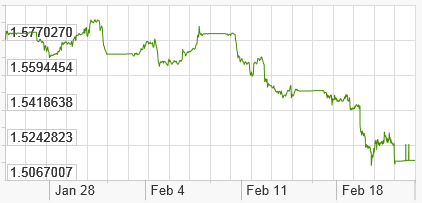There were three events last week that paved the way forward for the markets, namely: The minutes of the Federal Reserve Bank that exhibited some reservation about continuing accommodative monetary policy; the downgrading of the British economy from its AAA status by Moody’s in relation to the projected continuous weaknesses of the EU economy; and the fact that the G-20 meeting ultimately was unable to do anything regarding the cheapening of currencies, despite the pronouncements to the opposite.
Regarding the US fed policy we are of the opinion that it will continue being accommodative for the rest of the year and possibly for the first half of next year (under the leadership of the new Fed chair). This could only be disrupted if any of the following three things take place (which we don’t think that will take place): inflation increases significantly; unemployment drops below 7%; and GDP growth rate accelerates to 3%. We believe however that the US economy will continue growing more than the rest of the developed world and the dollar will strengthen against other major currencies, while the US will keep attracting foreign capital on its shores.
The downgrading of the British economy from the esteemed AAA status reflects the weaknesses of that economy which may softly be entering into currency cheapening policy territory in order to be able to attract capital and keep the financial machinery going. The fact that the projections this past week showed that the EU will remain in recession throughout 2013 (with a record unemployment level that will reach over 12.5%) do not help the situation, since it signifies that deleveraging in Europe may accelerate. The following graph shows the cheapening of the British sterling against the US dollar over the last month. Such downtrend – which we expect to continue – portrays the weak fundamentals of the British economy as well as UK’s central bank continuous purchases of financial assets (QE) and the softening of inflation targets in Britain.
In Japan, PM Abe openly asked the central bank to softened its inflation target and the appointment of the new head of the central bank will signify the desire to cheapen the yen further in order to boost exports and the economy in general. While we expect the Japanese market to perform well in 2013, we also think that the burden of debt in Japan (over 230% of its GDP) could be the entry point – projected after 18 months – for higher interest rates throughout the developed world.
These coordinated actions of currency depreciation – effectively endorsed by the leadership of G7 – have a triple effect: First, make hungry-for-yield investors to accumulate positions that under normal circumstances they would not have bought or at least demand higher yields. For example, in the last few months Bolivia sold debt in the markets after 90 years, and Ukraine bonds were oversubscribed. This hunt for higher yields may create financial bubbles, and that’s the concern reflected in the latest Fed’s minutes. Second, allow disproportional risks to be accumulated on financial assets whose volatility may prove to be dangerous when a flight to safety starts. Central banks need to keep yields on government bonds down (financial repression) in order to accommodate the funding of their respective economies’ debt. We do not expect this to change in the next 18 months, but we do expect the change to start from Japan. Third, the inflationary expectations will rise (originally at a sustainable level of 3.5%) at a time (projected in about three years) when the normalization of central banks balance sheets will be needed, but at that time that the fiscal path (including unfunded liabilities) will still be unsustainable.
As the postman rings the bell of “fiscal dominance” for developed economies (inability to meet its debt obligations) the central banks may be forced to abandon their independence and start transferring their assets to the Treasuries of their respective countries. That would be the time which will demonstrate that hard assets represent real money.
In the meantime, we still project an upswing market for the current year.

